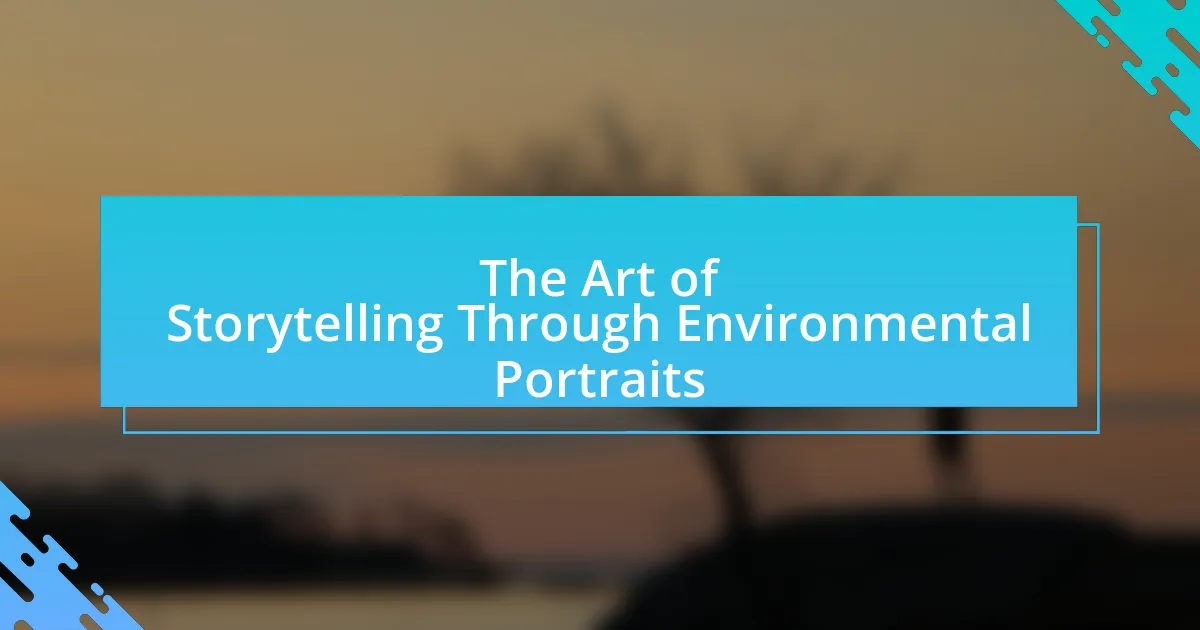Harnessing natural elements for unique outdoor portraits involves utilizing features such as light, landscape, and weather conditions to enhance the visual appeal and storytelling of photographs. Key aspects include the effective use of natural light, diverse backgrounds, and environmental textures, which contribute to the overall composition and emotional impact of the portraits. The article discusses techniques for leveraging natural elements, the significance of outdoor settings compared to studio environments, and strategies for overcoming challenges posed by unpredictable weather. Additionally, it highlights the importance of selecting appropriate locations and using essential tools and accessories to optimize outdoor portrait photography.

What does it mean to harness natural elements for unique outdoor portraits?
Harnessing natural elements for unique outdoor portraits means utilizing features such as light, landscape, and weather conditions to enhance the visual appeal and storytelling of the photographs. Photographers can leverage natural light, for instance, to create dramatic effects or soft, flattering illumination, while incorporating elements like trees, water, or mountains can add depth and context to the subject. The use of these elements not only enriches the composition but also connects the subject to their environment, making the portraits more engaging and authentic.
How can natural elements enhance outdoor portrait photography?
Natural elements enhance outdoor portrait photography by providing dynamic backgrounds, natural lighting, and unique textures that contribute to the overall composition. For instance, elements such as trees, water, and flowers can create visually appealing contrasts and depth, making portraits more engaging. Additionally, natural light, particularly during golden hour, softens shadows and highlights features, resulting in more flattering images. Studies have shown that incorporating natural settings can increase viewer engagement and emotional response, as subjects appear more relatable and authentic in their environment.
What types of natural elements are most effective in outdoor portraits?
Natural elements such as natural light, greenery, water, and textured backgrounds are most effective in outdoor portraits. Natural light enhances skin tones and creates depth, while greenery provides a vibrant backdrop that complements subjects. Water elements, like lakes or rivers, can add reflections and dynamic visuals, and textured backgrounds, such as rocks or trees, contribute to the overall composition and interest of the portrait. These elements collectively enhance the aesthetic quality and emotional impact of outdoor portraits.
How do lighting conditions affect the use of natural elements?
Lighting conditions significantly influence the use of natural elements in outdoor portraits by altering their visibility, color, and texture. For instance, during golden hour, the soft, warm light enhances the natural colors of elements like foliage and water, creating a more visually appealing backdrop. Conversely, harsh midday sunlight can create strong shadows and wash out colors, making natural elements less effective in composition. Studies show that photographers often prefer diffused lighting, such as overcast days, as it reduces contrast and highlights the details of natural elements, allowing for a more balanced and flattering portrayal.
Why is outdoor portrait photography significant?
Outdoor portrait photography is significant because it utilizes natural light and diverse backgrounds to enhance the subject’s features and create a more dynamic composition. Natural light provides a soft, flattering illumination that can highlight textures and colors, while outdoor settings offer unique elements such as landscapes, flora, and architectural features that contribute to the storytelling aspect of the portrait. Studies have shown that portraits taken in natural environments often evoke stronger emotional responses and connections from viewers, making them more impactful than studio portraits.
What are the advantages of outdoor portraits compared to studio settings?
Outdoor portraits offer advantages such as natural lighting, diverse backgrounds, and a relaxed atmosphere compared to studio settings. Natural lighting enhances the quality of images, providing soft, flattering illumination that can vary throughout the day, which is often more appealing than artificial studio lights. Additionally, outdoor environments provide a variety of backgrounds, from landscapes to urban settings, allowing for more creative and personalized compositions. The relaxed atmosphere of outdoor settings can also help subjects feel more comfortable, leading to more genuine expressions and interactions, which are crucial for capturing authentic moments.
How does the environment influence the mood of outdoor portraits?
The environment significantly influences the mood of outdoor portraits by providing context, lighting, and emotional resonance. Natural elements such as landscapes, weather conditions, and time of day can evoke specific feelings; for instance, a sunny day can create a cheerful and vibrant atmosphere, while overcast skies may impart a more somber or introspective mood. Research indicates that colors in the environment, like the greens of nature or the blues of water, can also affect emotional responses, enhancing the overall impact of the portrait. Therefore, the choice of setting and environmental factors are crucial in shaping the emotional tone of outdoor portraits.

What techniques can be used to effectively harness natural elements?
Techniques to effectively harness natural elements include utilizing natural light, incorporating natural backdrops, and leveraging weather conditions. Natural light, particularly during golden hour, enhances skin tones and creates a soft, flattering effect in portraits. Incorporating natural backdrops, such as trees, water, or mountains, adds depth and context to the images, making them visually appealing. Additionally, leveraging weather conditions, like fog or rain, can create unique atmospheres and moods, enhancing the overall composition. These techniques are widely recognized in photography, as they capitalize on the inherent beauty of the environment to elevate portrait quality.
How can photographers utilize natural light in their portraits?
Photographers can utilize natural light in their portraits by strategically positioning subjects to take advantage of the sun’s direction and quality. For instance, shooting during the golden hour, which occurs shortly after sunrise or before sunset, provides soft, warm light that enhances skin tones and reduces harsh shadows. Additionally, photographers can use reflectors to bounce light onto the subject, filling in shadows and creating a more balanced exposure. Research indicates that natural light can significantly improve the aesthetic quality of portraits, as it creates a more dynamic range of colors and textures compared to artificial lighting.
What are the best times of day for natural lighting in outdoor photography?
The best times of day for natural lighting in outdoor photography are during the golden hour, which occurs shortly after sunrise and just before sunset. During these times, the sunlight is softer and warmer, creating flattering conditions for portraits. The angle of the sun is lower, resulting in longer shadows and a more dynamic range of light, which enhances textures and colors in photographs. Studies in photography consistently highlight that shooting during these periods yields the most aesthetically pleasing results, as the light is diffused and less harsh compared to midday sun.
How can shadows and highlights be manipulated for artistic effect?
Shadows and highlights can be manipulated for artistic effect by adjusting their intensity and placement to create depth and mood in outdoor portraits. Photographers can use natural light sources, such as the sun, to cast shadows that enhance facial features or create dramatic contrasts. For instance, positioning subjects in relation to the light source can produce soft highlights on the face while allowing shadows to define contours, thus adding dimension. Techniques such as backlighting can create silhouettes, while reflectors can bounce light to fill in shadows, achieving a balanced exposure. Studies in photography emphasize that the interplay of light and shadow can evoke emotions and guide viewer focus, making these manipulations essential for artistic expression.
What role does the background play in outdoor portraits?
The background in outdoor portraits serves to enhance the subject and convey context, emotion, and storytelling. A well-chosen background can complement the subject’s features, create depth, and establish a mood that aligns with the intended message of the portrait. For instance, natural elements like trees, water, or mountains can evoke feelings of tranquility or adventure, while urban settings may suggest modernity or vibrancy. Studies in photography emphasize that backgrounds should not distract from the subject but rather support and enrich the overall composition, making the portrait more engaging and visually appealing.
How can natural landscapes enhance the composition of a portrait?
Natural landscapes enhance the composition of a portrait by providing depth, context, and visual interest that complements the subject. The inclusion of elements such as trees, mountains, or water can create a harmonious balance between the subject and the environment, drawing the viewer’s eye and adding layers of meaning. For instance, a portrait set against a vibrant sunset can evoke emotions of warmth and tranquility, while a rugged mountain backdrop may convey strength and resilience. Research indicates that backgrounds significantly influence viewer perception; a study published in the Journal of Experimental Psychology found that subjects rated portraits with natural settings as more appealing and engaging compared to those with plain backgrounds. This evidence supports the idea that natural landscapes not only enhance aesthetic value but also enrich the narrative of the portrait.
What should photographers consider when selecting a location?
Photographers should consider the natural light, background elements, and accessibility when selecting a location. Natural light influences the mood and quality of the photographs; for instance, golden hour provides soft, flattering light. Background elements, such as trees, water, or urban structures, can enhance the composition and storytelling of the portrait. Accessibility is crucial to ensure that both the photographer and the subject can easily reach the location, which can affect the overall experience and efficiency of the shoot.

What are common challenges when using natural elements in outdoor portraits?
Common challenges when using natural elements in outdoor portraits include lighting issues, unpredictable weather, and distractions from the environment. Lighting can vary significantly throughout the day, affecting the quality of the portrait; for instance, harsh sunlight can create unflattering shadows, while overcast conditions may lead to a lack of contrast. Unpredictable weather can disrupt planned shoots, as rain or wind can affect both the subject and the equipment. Additionally, environmental distractions, such as background clutter or movement from people or animals, can detract from the focus of the portrait. These factors necessitate careful planning and adaptability to achieve the desired outcome in outdoor portrait photography.
How can weather conditions impact outdoor portrait sessions?
Weather conditions significantly impact outdoor portrait sessions by influencing lighting, mood, and the overall aesthetic of the images. For instance, overcast skies provide soft, diffused light that reduces harsh shadows, making it ideal for flattering portraits. Conversely, direct sunlight can create strong contrasts and unflattering shadows on the subject’s face. Additionally, weather elements such as wind can affect hair and clothing, while rain can create unique, dramatic effects if captured correctly. Studies show that photographers often prefer shooting during the “golden hour,” shortly after sunrise or before sunset, when the light is warm and soft, enhancing the quality of outdoor portraits.
What strategies can be employed to work around adverse weather?
To work around adverse weather when capturing outdoor portraits, photographers can employ several strategies. Utilizing weather-resistant equipment, such as waterproof cameras and lenses, allows for continued shooting in light rain or snow. Additionally, scheduling shoots during the golden hour, when natural light is softer, can mitigate harsh lighting conditions caused by overcast skies.
Incorporating natural elements like umbrellas or canopies not only provides shelter but can also enhance the aesthetic of the portraits. Furthermore, scouting locations that offer natural windbreaks, such as trees or buildings, can protect subjects from strong winds.
These strategies are supported by the fact that many professional photographers adapt their techniques based on weather conditions, ensuring that they can still produce high-quality images regardless of the environment.
How can photographers prepare for unexpected changes in the environment?
Photographers can prepare for unexpected changes in the environment by carrying versatile gear and planning for various weather conditions. This includes using weather-resistant equipment, such as rain covers for cameras and lenses, and packing extra batteries, as cold or wet conditions can deplete battery life quickly. Additionally, photographers should monitor weather forecasts and have contingency plans, such as alternative locations or rescheduling options, to adapt to sudden changes. Studies show that being prepared can significantly enhance the quality of outdoor portraits, as adaptability allows photographers to utilize natural elements effectively, even in less-than-ideal conditions.
What are the best practices for capturing unique outdoor portraits?
To capture unique outdoor portraits, utilize natural light, diverse backgrounds, and creative angles. Natural light enhances skin tones and adds depth; shooting during golden hour provides soft, flattering illumination. Diverse backgrounds, such as foliage or urban settings, create visual interest and context, while creative angles can highlight the subject’s personality and features. According to a study by the American Society of Photographers, portraits taken in natural light are perceived as more authentic and engaging, reinforcing the effectiveness of these practices.
How can photographers creatively incorporate natural elements into their shots?
Photographers can creatively incorporate natural elements into their shots by using the environment as a backdrop or foreground to enhance the subject. For instance, framing a portrait with overhanging branches or wildflowers can add depth and context, making the image more engaging. Additionally, utilizing natural light, such as golden hour sunlight filtering through leaves, can create a warm and inviting atmosphere that highlights the subject’s features. Research indicates that images featuring natural elements can evoke emotional responses, as seen in a study published in the Journal of Environmental Psychology, which found that nature in photography can enhance viewer satisfaction and connection to the subject.
What tips can help in achieving the desired aesthetic in outdoor portraits?
To achieve the desired aesthetic in outdoor portraits, utilize natural light effectively by shooting during the golden hour, which occurs shortly after sunrise or before sunset. This time provides soft, warm lighting that enhances skin tones and creates a flattering atmosphere. Additionally, consider the background; choose locations with interesting textures or colors that complement the subject without overwhelming them. Incorporating elements like trees, water, or architectural features can add depth and context to the portrait. Lastly, pay attention to the composition by following the rule of thirds, which helps in creating balanced and visually appealing images.
What tools and equipment are essential for outdoor portrait photography?
Essential tools and equipment for outdoor portrait photography include a camera with a versatile lens, a tripod, reflectors, and external lighting sources. A camera, such as a DSLR or mirrorless model, allows for high-quality image capture, while a versatile lens, typically in the range of 50mm to 85mm, provides the ideal focal length for portraits. A tripod stabilizes the camera for sharp images, especially in low-light conditions. Reflectors help manipulate natural light, enhancing the subject’s features by bouncing light onto them. Additionally, external lighting sources, like speedlights or softboxes, can supplement natural light, ensuring well-lit portraits regardless of the environment. These tools collectively enhance the quality and creativity of outdoor portrait photography.
How can specific lenses enhance the use of natural elements?
Specific lenses can enhance the use of natural elements by allowing photographers to manipulate depth of field, focus, and perspective, thereby creating more dynamic and engaging outdoor portraits. For instance, a wide aperture lens can blur the background, emphasizing the subject against natural elements like trees or water, which adds depth and context to the portrait. Additionally, macro lenses enable close-up shots of natural textures, such as leaves or flowers, integrating these elements into the composition in a detailed manner. This technique not only highlights the beauty of the surroundings but also creates a harmonious relationship between the subject and nature, enhancing the overall visual impact of the portrait.
What accessories are beneficial for outdoor portrait sessions?
Beneficial accessories for outdoor portrait sessions include reflectors, diffusers, and portable lighting equipment. Reflectors help bounce natural light onto the subject, enhancing illumination and reducing shadows, which is crucial for achieving flattering portraits. Diffusers soften harsh sunlight, creating a more even light quality that is ideal for skin tones. Portable lighting equipment, such as speedlights or LED panels, provides additional light control, allowing photographers to adapt to varying outdoor conditions. These accessories are essential for optimizing natural light and achieving professional-quality outdoor portraits.
What are some practical tips for photographers looking to harness natural elements?
Photographers can effectively harness natural elements by utilizing natural light, incorporating environmental textures, and framing subjects with natural surroundings. Natural light, particularly during golden hour, enhances skin tones and creates soft shadows, making subjects appear more flattering. Environmental textures, such as trees, rocks, or water, add depth and interest to portraits, creating a more dynamic composition. Additionally, framing subjects with elements like branches or flowers can lead to visually appealing images that connect the subject with their environment. These techniques are widely recognized in photography, as they enhance the overall aesthetic and emotional impact of outdoor portraits.

















